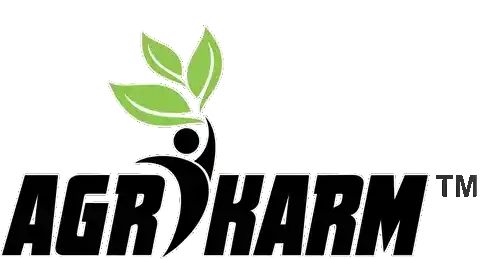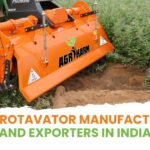
A good crop production requires farmers utmost time and efforts which can be saved by utilizing different kinds of farm implements.
Rotavators are of a great help to the farmers in today’s era of agriculture. Let’s find out below how you can choose an ideal rotavator for your tractor.
Basics of a Tractor Rotavator
A tractor rotavator, also known as a rotary tiller, is a farm implement used for soil preparation. It is an essential tool for modern agriculture, helping farmers to effectively prepare the soil for planting.
Components of Rotavator
- Blades: The main working parts of a rotavator machine are the blades, which rotate to cut and mix the soil. The number and type of blades can vary depending on the model and intended use.
- Rotary Shaft: The blades are attached to a rotating shaft driven by the tractor’s power take-off (PTO).
- Gearbox: This component transmits power from the tractor to the rotary shaft, controlling the speed and torque of the blades.
Types of Rotavator
- Single-Speed: These types of rotavators have a fixed speed and are suitable for general purpose tilling.
- Multi-Speed: Multi-Speed tractor rotavator allows for speed adjustment, providing more control and flexibility for different soil types and conditions.
- Heavy-Duty: Designed for tough conditions and larger areas, heavy-duty tractor rotavators are robust and can handle more intense soil preparation tasks.
Check out Agrikarms different types of Rotavators and decide which is ideal for your farm.
Functions of a Tractor Rotavator
Some of the main functionality of a tractor rotavator includes:
- Soil Tilling and Cultivation: Rotavators break up, churn, and aerate the soil, making it more suitable for planting by creating a fine, even seedbed. This improves soil structure and promotes root growth.
- Weed Control: By cutting through and mixing the soil, rotary tiller helps in uprooting and burying weeds, reducing their growth and competition with crops.
- Incorporation of Organic Matter: Rotavators mix organic matter such as crop residues, manure and compost into the soil, enhancing soil fertility and structure.
- Seedbed Preparation: Tractor with Rotavator prepares the soil for planting by creating a smooth and level surface, ensuring better seed-to-soil contact and uniform germination.
- Soil Aeration: By turning the soil, tractor rotavators help improve soil aeration, which is crucial for root respiration and the activity of soil microorganisms.
- Moisture Retention: Proper tilling with a rotavator helps in better moisture retention in the soil, which is beneficial for crop growth, especially in dry conditions.
- Pest and Disease Management: By burying crop residues and organic matter, tractor rotavators can help reduce pest and disease problems by depriving pests of habitat and food sources.
How to Choose a Tractor Rotavator for Your Farm?
Choosing the right tractor rotavator for your farm involves considering several key factors to ensure it meets your specific needs.
Here are the steps to guide you in selecting the appropriate rotavator machine:
Assess Your Farm’s Needs
- Farm Size: Larger farms may require wider and more powerful tractor rotavators to cover more ground quickly.
- Soil Type: Different soils (sandy, clay, loamy) have varying levels of hardness and require different rotavator specifications.
- Crops: The type of crops you are cultivating can influence the depth and width of tilling required.
Tractor Compatibility
- Horsepower (HP): Ensure your tractor has sufficient horsepower to handle the rotavator machine. Check the manufacturer’s recommendations for the rotavator’s power requirements.
- PTO (Power Take-Off): Verify that the PTO shaft specifications match between the tractor with rotavator.
Rotavator Specifications
- Width: The working width of the rotary tiller should match your row spacing and field size.
- Blades: The type and number of blades affect the tilling quality. C-shaped blades are common for general use, while L-shaped blades are better for tougher soils.
- Depth Control: Adjustable depth settings allow for flexibility in different soil conditions and crop requirements.
Quality and Durability
- Build Quality: Look for robust construction with durable materials to ensure longevity.
Maintenance and Service
- Ease of Maintenance: Consider how easy it is to maintain and repair the rotavator. Availability of spare parts and service centers is crucial.
- Warranty: Check the warranty period and what it covers.
Cost
- Budget: Determine your budget and compare the features and benefits of rotavators within your price range.
- Long-term Investment: Consider the cost of ownership, including maintenance, repairs and potential downtime.
Field Demonstration
- Trial Run: If possible, arrange for a demonstration on your farm to see how the rotavator performs in your specific conditions.
User Reviews and Feedback
- Farmer Reviews: Talk to other farmers and read reviews to get insights into the performance and reliability of different rotavator models.
FINAL VERDICT
Rotavators are vital for modern farming, providing efficiency and versatility in soil preparation. By considering the above mentioned factors, you can make an informed decision and choose a rotavator that best suits your farm’s needs. By choosing the right tractor rotavator, farmers can significantly enhance their productivity and crop yields.


 Admin
Admin 

